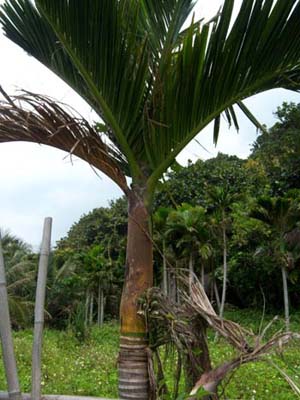Areca catechu var. batanensis Information
A solitary, smallish, water-loving, fast growing, monoecious, forest emergent, crownshaft palm. Common in cultivation, always cultivated in the wild. It has a smooth, grey trunk, 6.1 m. (20 ft.) tall, 20.3 cm. (8 inch) diameter with spaced ring leaf scars, and large segmented, pinnate (feather) leaves, 1.5 m. (5 ft.) long, 0.6 m. (2 ft.) wide, green above and beneath.
This form is the small seeded form, and seems to have originated in the Philippines, and is often the only form to be seen locally, although it can sometimes be planted together with the tall form. Can also be seen in Thailand and some other South East Asian countries however, these other Asian dwarf forms have larger, rounder seeds than the Philippine dwarf. This plant is suitable, while young as a houseplant or conservatory plant.
Areca catechu var. batanensis can tolerate close to freezing conditions. But low temperatures are best avoided. It naturally occurs in wet rainforest or seasonally wet forest in low montane locations. In this type of natural environment temperature fluctuations are slight, and this palm prefers a constantly cool or mild climate with little temperature difference between day & night, and Summer & Winter. Under extreme cold conditions we recommend you keep this palm as dry as possible, and well wrapped up.
Identification:
Dwarf trees reaching only 4-5 m tall. Seeds are also smaller. This is the distinctive form found in the wild state growing on Lanyu Island, Taiwan, and Batanes Islands of the Philippines, Batan Island, Basco, along a mountain streams.
General Information:
As these two islands are the only known place for this palm to occur in the wild Lanyu Island and Batan Island of the Philippines are most certainly the origin. Unripe seeds contain a mild narcotic and have been chewed by native peoples for centuries. Seeds germinate within 2 months and grow rapidly.
Distribution:
Native to
Work in progress
Distribution Information currently being revised!

